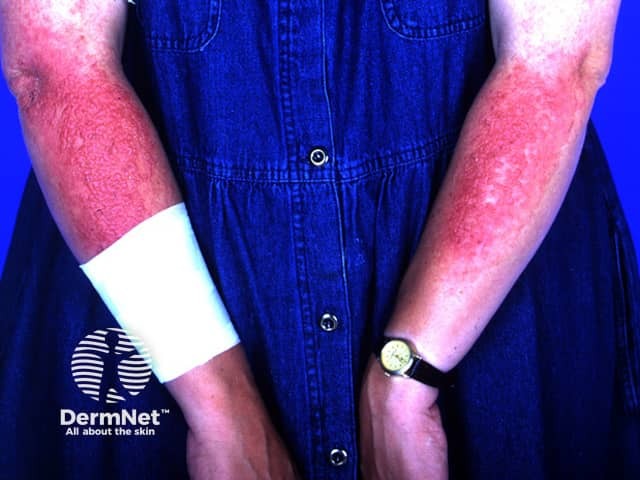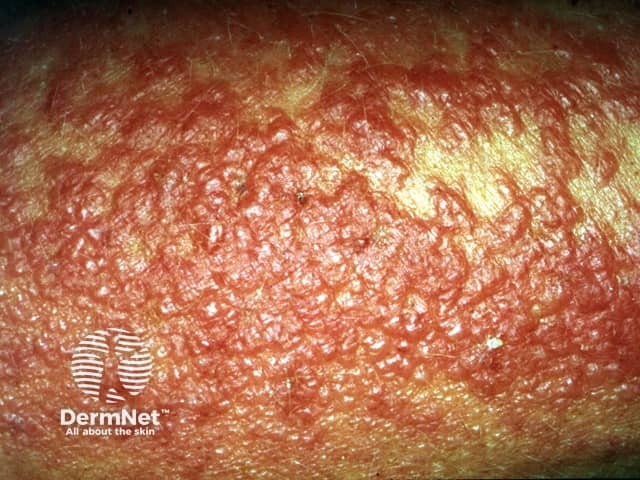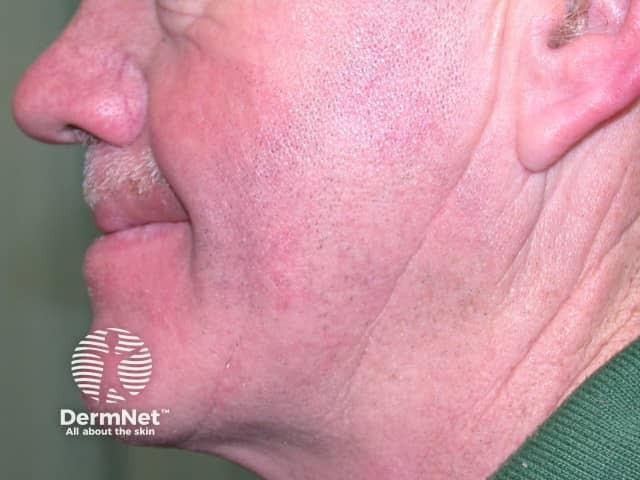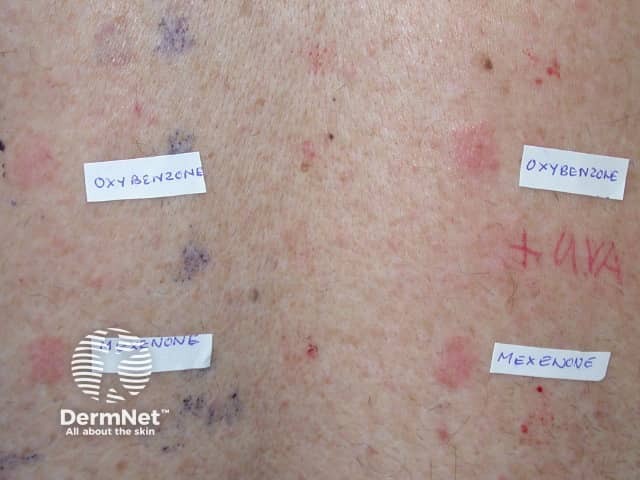Main menu
Common skin conditions

NEWS
Join DermNet PRO
Read more
Quick links
Sunscreen allergy — extra information
Introduction Causes Reactions Diagnosis Treatment Prevention
Introduction
Nowadays there are hundreds of different brands of sunscreens available for use. These products usually contain one or more active chemicals that absorb or block harmful UV rays, fragrances, preservatives and a base such as lanolin (wool alcohols). With their increasing use over the last few decades it is not surprising to see contact allergic dermatitis due to these products.
What causes sunscreen allergy?
Contact allergic dermatitis to sunscreens can occur as a result of an allergy to any one of the many ingredients found in these products. Some of the chemical absorbers used in topical sunscreens may be more sensitizing to some individual than others. In addition, individuals may also have a sensitivity to the fragrances and preservatives found in sunscreens.
What are the reactions to sunscreen allergy?
Typical allergic contact dermatitis may occur in individuals allergic to any of the ingredients that are found in sunscreen products or cosmetic preparations that have a sunscreen component. The rash can occur anywhere on the body where the substance has been applied and sometimes may spread to unexpected sites.
In some cases, sunscreen allergy may cause a photocontact dermatitis in which the areas affected usually occur in a sun-exposed pattern on the body and where sunscreen has been applied. These areas often include the face, arms, backs of the hands, “V” shaped area of the upper chest and lower neck. Usually the upper eyelids, area under the chin and behind the ears are not affected.

Sunscreen dermatitis

Sunscreen dermatitis

Sunscreen dermatitis
Am I allergic to sunscreens?
Due to sunscreen products containing multiple active ingredients it is often difficult to determine the cause of dermatitis. Patch testing for the individual component is the only exact method for determining which of the chemicals the allergen is.
Patch testing and photopatch testing of topical sunscreen preparations may be performed if the active sunscreen ingredient is the suspected allergen. The prevalence of allergy to chemical absorbers in sunscreens is not known for the general population, however, in patch test clinics the prevalence of allergy to the active sunscreen component appears to be quite low. On the other hand, photopatch testing shows sunscreen chemical absorbers to be a common cause of photoallergic contact dermatitis. Hence it is important to carry out photopatch testing in addition to patch testing.

Oxybenzone and mexenone allergy on patch testing with photoaggravation

Sunscreen dermatitis
Many allergies to sunscreen products are caused by the inactive components such as the fragrances or preservatives that are used. Patch testing using fragrance mix and Balsam of Peru detects approximately 75% of fragrance allergy cases. A positive patch to fragrance mix indicates that you are allergic to one or more fragrance chemicals. An estimated 1-2% of the general population is allergic to fragrance.
Self-testing a product for sunscreen allergy is possible but should be done only after first talking with your doctor. Apply a small amount (50 cent sized area) of the product to a small tender area of skin such as the bend of your arm or neck for several days in a row. Examine the area each day and if no reaction occurs, it is unlikely you are allergic to it. However, it may still not be suitable for you as it can still cause irritant contact dermatitis.
Treatment of dermatitis caused by sunscreen allergy
Once the dermatitis appears on the skin, treatment is as for any acute dermatitis/eczema, i.e. topical corticosteroids, emollients, treatment of any secondary bacterial infection (Staphylococcus aureus), etc.
What should I do to avoid sunscreen allergy?
If you have a sunscreen allergy the best way to avoid any problems is by avoiding all products that contain any of the substances that you have a sensitivity to.
If you have a sunscreen allergy, metal oxide sunscreens such as titanium dioxide and zinc oxide may be suitable. These have not been reported to cause allergic contact dermatitis. Although cosmetically less pleasing, they have been proven to be safe and effective sunscreen agents.
Your dermatologist may have further specific advice, particularly if you are highly sensitive to sunscreen products.
References
- Book: Fisher's Contact Dermatitis. Ed Rietschel RL, Fowler JF. Lippincott Williams & Wilkins 2001
On DermNet
- Specific sunscreen chemicals
- Other relevant pages
Other websites
- T.R.U.E. tests
- Allergy New Zealand
- Occupational Dermatology Research and Education Centre, Australia
- Allergic contact dermatitis — Medscape Reference
